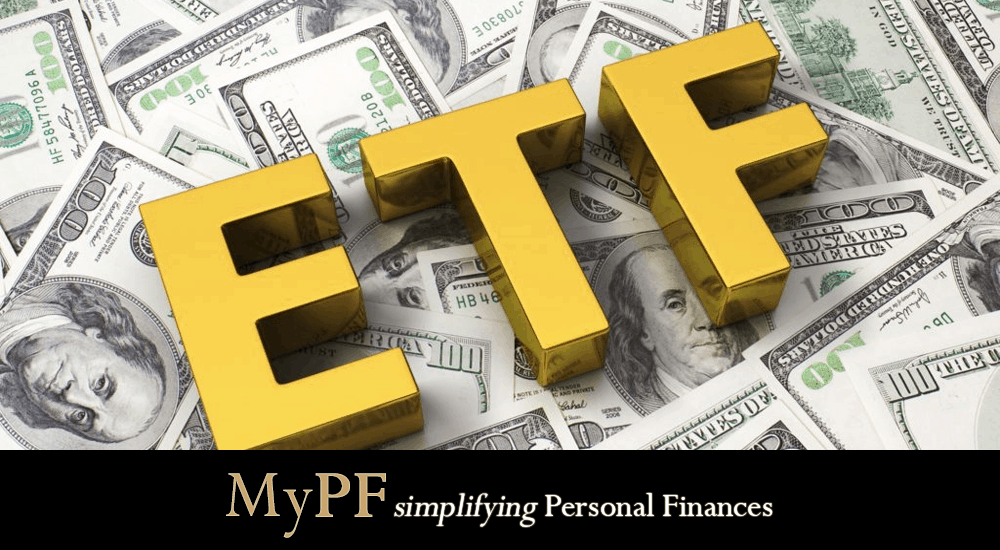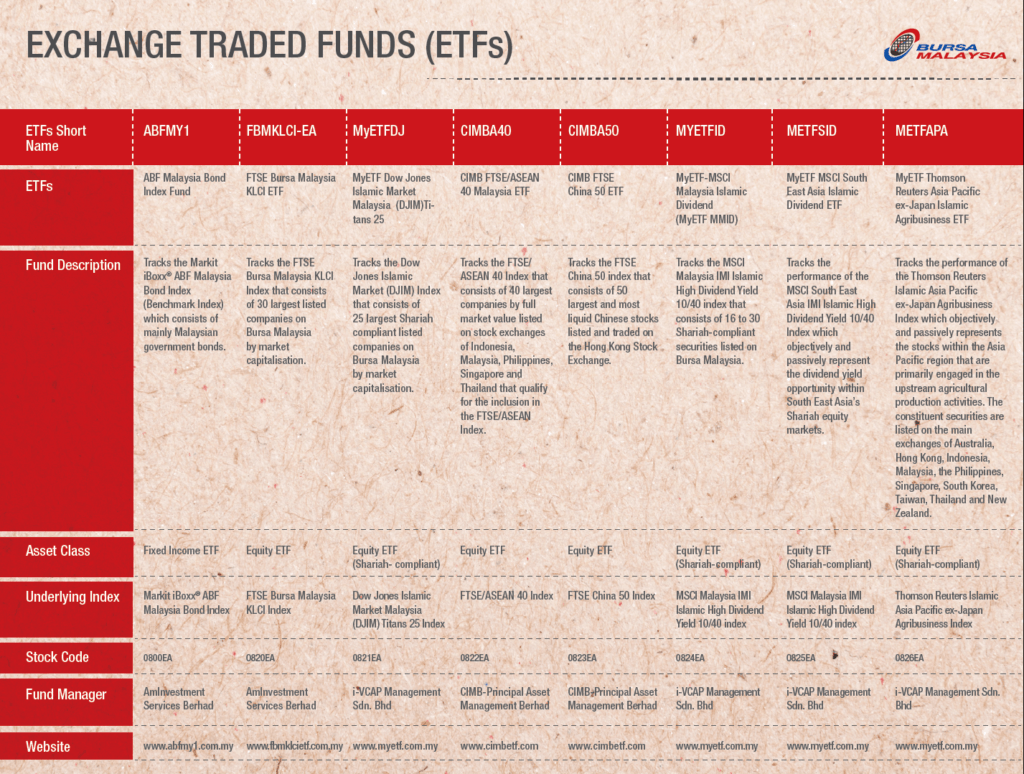Investing in Exchange Traded Funds (ETFs). What are ETFs, pros and cons? Should you invest in ETFs in the US, globally, and/or in Malaysia?

What are Exchange Traded Funds (ETFs)?
ETFs are listed on the stock exchange. With an ETF, you buy a number of stocks/bonds/other investments which represent an index (aka index tracker)
An Authorized Participant (AP) or Market Maker creates and redeem ETF units
- To create shares of an ETF, the AP will purchase all the securities that make up the ETF in proportion to the overall portfolio. This “basket” of securities is then exchanged with the ETF issuer for to create units of the ETF.
- Likewise in reverse, to redeem shares on an ETF, the AP will accumulate a number of ETF units in exchange of a “basket” of securities of equivalent value.
ETF Pros & Cons
ETF Pros
- Diversification with a single purchase including asset diversification, and possibly regional/international diversification.
- Trading of ETFs anytime and immediately (as long as there is a willing buyer and seller) when the market is available for trading.
- Lower buying/annual fees compared to mutual funds/unit trusts.
- ETFs may pay dividends which are generally tax-free (in countries that have investment income taxes) until you sell.
“After I die, I would put my money into a super-simple, ultra-low-cost, index fund which tracks the 500 biggest companies in America — otherwise known as the S&P 500. I believe the long-term results from this policy will be superior to those attained by most investors — whether pension funds, institutions, or individuals — who employ high-fee managers” ~Warren Buffett
ETF Cons
- ETFs although diversified can be volatile especially if the ETF focuses on a particular sector.
- Although lower fees (in Malaysia) than Unit Trusts, you still incur brokerage and other fees which can add up especially if you make many transactions.
- You may face difficulties trading in ETFs that are not heavily traded (re: low volume/liquidity) with not many buyers and sellers.
- Overseas ETFs may still be subject to taxes (i.e. US ETFs have a 30% withholding tax).
How to Buy an ETF in Malaysia
You incur costs like buying and selling stocks when buying an ETF, including brokerage commission, stamp duty and clearing fees.
Like shares, ETFs are traded in minimum lots of 100 units in Bursa Malaysia and as low as 1 unit in international markets.
Look for very low fee ETFs especially if you are planning to invest over time using dollar-cost averaging (which is suggested).
Should you invest in ETFs?
Questions you should ask before investing include:-
- What is your investment timeline and objectives?
- What is the investment objective and strategy of the ETF?
- What is the dividend policy (if any) for the ETF?
- What fees and charges will you be paying?
- How reputable and trustworthy is the company managing the ETF?
Malaysian ETFs generally have low trading volume and have market makers (except ABF Malaysia Bond Index Fund).
Market Maker: a dealer in securities or other assets who undertakes to buy or sell at specified prices at all times.
In the United States, the SPDR S&P 500 ETF ($SPY) is the 2nd most actively traded fund in the whole world.
Investing in ETFs can start from as low as RM1,500 (USD300) whether directly into ETFs or as low as RM100 using robo advisory services (aka digital wealth managers). A robo advisor uses a portfolio approach to help you select a basket of ETFs and the performance of is affected by the ETFs that make up the portfolio which will vary according to your selected risk profile.
Working with a good financial planner will help you to make better decisions and help you learn how to invest in ETFs.
Example of US ETFs
[stock_market_widget type=”table-quotes” template=”basic” color=”default” assets=”SPY,IVV,VTI,VOO,QQQ,IWM,DIA” fields=”logo_name,price,change_abs,change_pct,previous_close” display_header=”true” display_chart=”false” pagination=”true” rows_per_page=”30″ sort_field=”market_cap” sort_direction=”desc” api=”yf” markups=”{name},{name},{name}” urls=”,,,” style=”font-size:small”]
Example of Bursa Malaysia ETFs
[stock_market_widget type=”table-quotes” template=”basic” color=”default” assets=”0800EA.KL,0822EA.KL,0823EA.KL,0820EA.KL,0827EA.KL,0821EA.KL,0824EA.KL,0825EA.KL,0826EA.KL,0828EA.KL,0829EA.KL” fields=”logo_name,price,change_abs,change_pct,previous_close” display_header=”true” display_chart=”false” pagination=”true” rows_per_page=”30″ sort_field=”market_cap” sort_direction=”desc” api=”yf” markups=”{name},{name},{name}” urls=”,,,” style=”font-size:small”]
Types of ETFs
The largest market in the world for ETFs is the US market which has many different themes (i.e. sectors) and different strategies available.
Example of different strategies including following market weight, or being alternatively weighted.
Alternative Weighted Strategies
- Equal weighted: stock components equally weighted
Note: This favors smaller companies as gives them equal weightage as larger companies - Factor tilt: favors stocks which give highest dividend yield
Factor Investing Strategies: focuses on higher returns and lower volatility
- Yield: focus on yields and dividends.
- Momentum: invest in companies with positive momentum (and may short stocks with negative momentum).
- Value: focus on undervalued stocks based on fundamentals.
- Quality: attempts to select stocks that outperform in return on equity, earnings variability, and debt-to-equity.
- Volatility: includes exposure to volatility without having to buy options.
- Size: tracks large and mid-cap stocks based on market cap inverse.
Leverage and Inversed Strategies
- Leveraged: uses leverage (typically debt) to multiply the returns (and losses) of an index/benchmark.
- Inversed (aka Short ETF): is constructed to return the opposite of an index/benchmark.
ETF Investment Strategies
A few options for ETF investment strategies include full replication, partial replication, synthetic, futures-based, and smart Beta. Each strategy may have a tracking error (difference) with the closest being full replication.
- Full replication copies all (or most) of a particular index.
- Partial replication copies most but not all. Reasons could possibly be that they don’t have access to a particular stock thus requiring a proxy.
- Synthetic is where a ETF buys a derivative where they can go to an investment bank and swap.
- Futures-based uses futures to replicate the index.
- Smart Beta strategy consists both active and passive investing. This is an active strategy replacement and there’s value add with fund management input. ETF manager may have a value bias and the index use certain metrics or calculation to make automatic selection based on rules.
Smart Beta captures factor exposures using a rules-based, systematic approach. It eschews traditional cal-weighted strategy but takes into account factors granular to a company or industry, and/or exhibiting certain behavior or metrics such as earnings growth, dividend yield, momentum, and profitability.


Hello, how can I invest US ETF from Malaysia? Thanks!
I open a brokerage account with Rakuten Trade but METFUS50 is not listed there. Do you know which online brokerage firm support the ETF like this one?
Hi, you mentioned that US ETF has a 30% withholding tax, what does that mean and how does that impact me as a Malaysian buyer?
Can you advise us on the Robo Adviser and how practical is the Robo Adviser?
https://mypf.my/2019/10/22/wahed-invest-is-malaysias-1st-islamic-robo-advisory/
https://mypf.my/2018/11/01/my-etf-robo-advisory-stashaway/
hi, thanks for the great article. i have just started reading up on investment in the share market. seems like the US has the most active ETF market…
my question is, if i were to invest in an index fund ( for eg. the vanguard total market index fund). do i buy in thru a broker or do i buy in direct to fund house(vanguard) ?
If so, would you know the process of how it can be done from malaysia… funding it and of course cashing out in future for example… thank you in advance.’
More info: https://mypf.my/members/services/global-brokerage/ (free membership registration required)